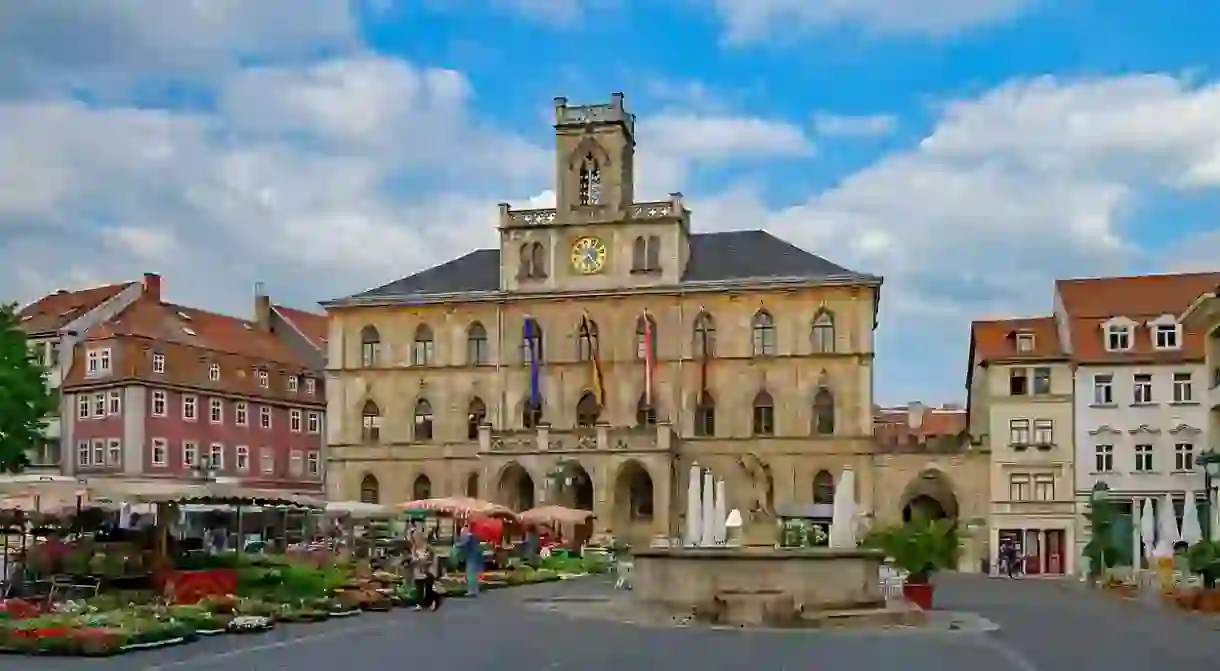Weimar's Most Beautiful Buildings

One of the must-see places in Germany’s central state of Thuringia is Weimar, a charming town of historical significance that is also closely tied to the country’s greatest poets. A tour of the city will take you past some imposing buildings and richly decorated façades that are dotted around the city. Here’s a list of Weimar’s most beautiful buildings.
Cranach House
Building

On the eastern end of Weimar’s beautiful market square stands Cranach House, one of two almost identical Renaissance buildings. Lucas Cranach the Elder is considered one of the most important painters of the Renaissance period, and, at the advanced age of 80, the artist opened a studio here. The beautiful façade catches your eye with the stone columns that frame the windows and the front door, the circular arches, the richly adorned alcoves and Cranach’s coat of arms symbol, the winged serpent. Today, the building is home to the small theatre Theater im Gewölbe.
Weimar City Palace
Building

The neoclassical palace at the western fringe of the Old Town replaces the 17th-century Baroque palace that was destroyed by a large fire in 1774. The reconstruction spanned over a period of 500 years, and some of the rooms are dedicated to the renowned poets who worked in Weimar – Goethe, Schiller, Herder and Wieland. Today, the building is home to the Schlossmuseum, which displays a collection of paintings from the 15th and 16th centuries, as well as artworks related to Weimar.
National Theatre
Building

Weimar’s national theatre was once the place where some of Goethe’s and Schiller’s works premiered. But once again, a fire is to blame for the destruction of the first neo-classicist building. After the 1825 fire, a new building opened its doors in 1908 and in its time saw a couple of historic events, including the first national assembly of the Weimar Republic in 1919. World War II bombs destroyed the theatre again, before it reopened with Goethe’s Faust in 1948.
Duchess Anna Amalia Library
Library

Wedged in between the historic Platz der Demokratie square and the vast meadows of the Park an der Ilm, the restored ornate Duchess Anna Amalia Library lures with a fascinating collection of more than a million books, historic documents, maps and music. Set in a historical building, the real beauty of the library only unveils itself when you step inside Rococo Hall. Hardwood floors, gold elements, stucco ornaments and busts of Goethe, Schiller and other important figures decorate the interior.
Town Hall
Building

Across the market square from Cranach House, the old Town Hall towers over the hustle and bustle of Weimar’s city centre. The neo-Gothic building you marvel at today dates back to 1841 and was constructed after the previous town hall building burned down not only once, but twice. Only the two stone portals and the town’s coat of arms survived the last fire and were integrated into the new façade. Four times a day, a Meissen porcelain carillon sounds over the market square, and during the Christmas period, the windows of the Town Hall serve as doors of an oversized Advent calendar.
Fürstenhaus
Building

Around the corner from the Duchess Anna Amalia Library is the so-called Fürstenhaus. The imposing three-storey building wows with its red-shingled mansard roof and the columned porch that was added in 1889. The mansion served as the intermittent residence of the Ducal family in the 18th century – hence the name – before housing the Princely Free Drawing School and becoming the provisional seat of the Landtag of Thuringia in 1918. Since 1951, it’s been the home of the Franz Liszt University of Music.
Stadthaus
Building

After the brilliantly designed early Renaissance building was destroyed by World War II bombing raids, the historic façade was meticulously reconstructed by 1971. Now the green-and-white front and the gabled roof stand shoulder to shoulder with the Cranach House next door. The times when masquerade balls, lectures and concerts were held here have passed; today, the tourist information centre occupies the ground floor and administrative offices the upper floors.













